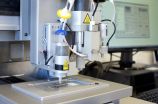(Press-News.org) Researchers from Cardiff University have pioneered a new technique that will enable scientists to precisely pinpoint the areas on an enzyme that help to speed up chemical reactions.
By labelling certain segments of an enzyme with heavy isotopes, the researchers have found that 'heavy' and 'light' versions of enzymes have different catalytic properties, allowing them to determine which regions are linked to specific functions.
It is hoped this precise pinpointing may shed light on why enzymes are much more efficient at speeding up chemical reactions compared to man-made catalysts, and could have wide-reaching implications for a range of industries, such as the creation of manufactured goods, biofuels and therapeutic drugs.
Lead author of the study Professor Rudolf Allemann, distinguished research professor and head of Cardiff University's School of Chemistry, said: 'Enzymes are not only central to living systems, but also to many industrial processes, such as the production of food, textiles, detergents, pharmaceuticals and other chemicals where environmentally friendly methods are of ever increasing importance.
'We've been able to show, for the first time, that different parts of an enzyme affect different aspects of its function. The method we've developed can be applied to a wide range of pharmaceutically and industrially important enzymes, and will lead to new candidates for biological and medical applications, and new production routes for enzymes of industrial use.'
Enzymes are proteins that drive nearly all chemical reactions that take place in living systems.
Researchers around the world are striving to understand exactly how enzymes increase reaction rates, as they typically operate much more efficiently, and in more friendly conditions, than man-made catalysts that are used in industry. It is estimated that man-made catalysts underpin the creation of 80 to 90 percent of all manufactured goods.
Whilst researchers have a good understanding of the chemistry of enzymes, they are less sure about how enzymes physically react with their targets, specifically how the movements or vibrations of an enzyme can drive the chemical reactions.
In their study, the research team, consisting of researchers at Cardiff University's School of Chemistry, the University of Valencia and Jaume I University in Spain, investigated the physical movements of the enzyme dihydrofolate reductase (DHFR).
DHFR is a small enzyme that plays an essential role in the building of genetic material and proteins, and was the first enzyme to be targeted for chemotherapy cancer treatment. Drugs were designed to bind strongly to DHFR to prevent it from working, which would stop rapidly reproducing cells -- such as cancer cells -- from proliferating.
The researchers altered the weight of DHFR by adding heavy isotopes -- specifically carbon, nitrogen and hydrogen -- onto certain segments of the enzyme. As a result of the additional weight the enzyme moved slower, but its chemical properties remained unchanged.
By strategically altering different parts of the enzyme and recording how the chemical reactions changed, the researchers were able to determine the dynamic role that specific regions of the enzyme played in chemical reactions.
The study has been published in the journal Angewandte Chemie.
INFORMATION:
Notes to editors
1. For further information, contact:
Michael Bishop
BishopM1@cardiff.ac.uk
Tel: 02920 874499
Cardiff University
2. Cardiff University is recognised in independent government assessments as one of Britain's leading teaching and research universities and is a member of the Russell Group of the UK's most research intensive universities. The 2014 Research Excellence Framework ranked the University 5th in the UK for research excellence. Among its academic staff are two Nobel Laureates, including the winner of the 2007 Nobel Prize for Medicine, University Chancellor Professor Sir Martin Evans. Founded by Royal Charter in 1883, today the University combines impressive modern facilities and a dynamic approach to teaching and research. The University's breadth of expertise encompasses: the College of Arts, Humanities and Social Sciences; the College of Biomedical and Life Sciences; and the College of Physical Sciences and Engineering, along with a longstanding commitment to lifelong learning. Cardiff's flagship Research Institutes are offering radical new approaches to pressing global problems. http://www.cardiff.ac.uk
LOS ANGELES -- In two ancillary studies of two multi-center international clinical trials led by the University of Southern California (USC) Eye Institute, the injectable drug ocriplasmin appears to improve vision among patients suffering from symptomatic vitreomacular adhesion (VMA), a condition related to the aging eye that could cause permanent vision loss if left untreated.
'These are the first large studies that document patient-reported visual improvement after injection of ocriplasmin for symptomatic VMA,' said Rohit Varma, M.D., M.P.H., director of the USC Eye ...
Lisbon, 17 June 2015: An IVF technique which freezes all embryos generated in an initial treatment cycle and transfers them in a later cycle as freeze-thawed embryos does not improve outcome as some studies have suggested.
Results of the study, performed at the Instituto Valenciano de Infertilidad (IVI) clinic in Valencia, Spain, are presented today at the ESHRE Annual Meeting by Dr Ernesto Bosch, Medical Director of IVI Valencia, Spain.
As background to his report, Dr Bosch noted that several studies have found improved outcomes in IVF when all embryos are electively ...
Nyon, Switzerland - June 17, 2015 -- An International Osteoporosis Foundation (IOF) Working Group on Skeletal Rare Diseases has published a new classification of rare genetic metabolic bone disorders (RGMBDs) according to their metabolic pathogenesis.
Skeletal Rare Diseases such as osteogenesis imperfecta, juvenile Paget's disease or osteopetrosis, are only three of the more than 400 developmental abnormalities of the skeletal system that affect patients worldwide. Although rare, these 'orphan' diseases have a very serious, and often devastating, impact on the lives ...
Scientists at the Ruhr-Universität Bochum established a mouse model for the human disease SCA6. SCA6 is characterised by movement deficits and caused by similar genetic alterations as Chorea Huntington. The mouse model will be used to investigate the disease mechanisms. Experiments suggest that an impairment of eye blink conditioning could be an early disease symptom. The team from the Department of Zoology and Neurobiology published their data in the Journal of Neuroscience; the work was highlighted by the editor's commentary.
Spinocerebellar ataxia 6: structural ...
This news release is available in German. Ragweed (Ambrosia artemisiifolia) - an otherwise unremarkable plant - produces pollen that can trigger strong allergic reactions such as asthma even in very small quantities. Scientists from Technische Universität München (TUM) and Helmholtz Zentrum München have now published a joint study showing that the substance previously identified as the major allergen only induces such a vigorous allergic response in combination with the adenosine also present in the pollen.
Ragweed only started to become widespread ...
A group of researchers at Chalmers University of Technology have managed to print and dry three-dimensional objects made entirely by cellulose for the first time with the help of a 3D-bioprinter. They also added carbon nanotubes to create electrically conductive material. The effect is that cellulose and other raw material based on wood will be able to compete with fossil-based plastics and metals in the on-going additive manufacturing revolution, which started with the introduction of the 3D-printer.
3D printing is a form of additive manufacturing that is predicted to ...
Astronomers have long theorised the existence of a first generation of stars -- known as Population III stars -- that were born out of the primordial material from the Big Bang [1]. All the heavier chemical elements -- such as oxygen, nitrogen, carbon and iron, which are essential to life -- were forged in the bellies of stars. This meansthat the first stars must have formed out of the only elements to exist prior to stars: hydrogen, helium and trace amounts of lithium.
These Population III stars would have been enormous -- several hundred or even a thousand times more ...
Scientists have developed a new tissue 'scaffold' technology that could one day enable the engineering of large organs.
Research led by the Universities of Bristol and Liverpool has shown that it is possible to combine cells with a special scaffold to produce living tissue in the laboratory. It is hoped this can then be implanted into patients as a way of replacing diseased parts of the body.
Until now, the approach has generally been limited to growing small pieces of tissue, as larger dimensions reduce the oxygen supply to the cells in the centre.
A team of ...
HOUSTON, June 18 -- Taking research from the lab to the clinic can be a long and arduous process, but necessary to ensure new therapeutic methods are safe. This typically involves models created in the lab to closely resemble the cellular mechanism of the human body.
Researchers at Baylor College of Medicine say they have now created a new disease model that more than just resembles the human mechanisms; it acts as a fully functioning human lipid system within a mouse to specifically study hypercholesterolemia, a form of high cholesterol caused by a genetic defect.
The ...
About a fifth of all U.S. children live in poverty. These children are more likely to experience learning and cognitive delays. Researchers have tried to determine causes for this disparity, with recent work identifying the hormone cortisol as a possible reason because of its ability to pass the blood-brain barrier. Cortisol is one of the most influential hormones in the human body, often referred to as the stress hormone because it's secreted into the bloodstream at higher levels as part of the body's flight-or-fight response. Now a new study has identified how specific ...

